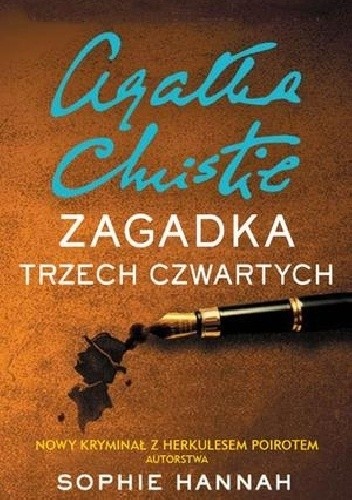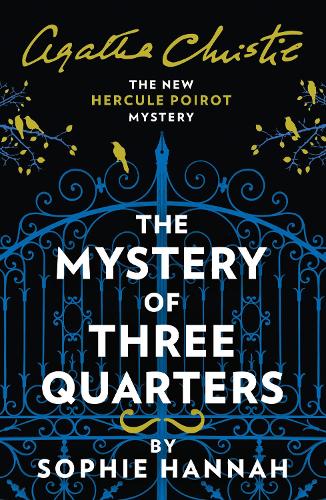„Zagadka trzech czwartych”, Sophie Hannah "The Mystery of Three Quarters", Sophie Hannah
1 śmierć i 4 listy
- Sylvia Rule
- John McCrodden
- Annabel Treadway
- Hugo Dockerill
Czworo ludzi oskarżonych o zamordowanie człowieka nazwiskiem Barnaba Pandy. Każde z nich dowiedziało się o fakcie oskarżenia listownie. A każdy z listów został podpisany przez… Herkulesa Poirota! Cała czwórka, niezależnie od siebie, spotyka się ze sławnym detektywem, aby – w mniej lub bardziej ostrych słowach – zaprzeczyć jakiemukolwiek udziałowi w śmierci tego człowieka. Panna Treadway jest, jak się okazuje, jego wnuczką i to właśnie ona wie najwięcej o okolicznościach zgonu. Nieszczęśliwy wypadek, utonięcie w wannie. A więc dlaczego ona i pozostałe oskarżone osoby dostały te dziwne listy? Poirot jest tym faktem dość mocno zdziwiony, szczególnie, że to z pewnością NIE ON był oskarżycielem. Nawet nie znał pana Pandy’ego; jego nazwisko poznał dopiero przy okazji spotkania z panią Rule. Postanawia więc rozwiązać zagadkę tajemniczej korespondencji.
Ciasto jako rozwiązanie? To możliwe!
Jakie związki istnieją pomiędzy panem Pandym a osobami oskarżonymi o jego morderstwo? Panna Treadway jest jego wnuczką. Sylvia Rule? Jej syn uczęszcza do tej samej szkoły co prawnuk zmarłego, Timothy. John McCrodden? Ten zdaje się nie mieć z nim żadnego związku. Hugo Dockerill był kierownikiem internatu, w którym mieszkał wspomniany wcześniej Timothy. A czy istniały jakieś związki pomiędzy tymi osobami? To kolejny punkt na liście rzeczy do odkrycia. W rozwiązaniu tej części zagadki pomaga naszemu detektywowi… jego przyjaciółka, Euphemia Spring zwana „Fee”, pracująca jako kelnerka w Pleasant’s Café. A dokładniej upieczone przez nią ciasto w formie szachownicy, które później pomoże Poirotowi także znaleźć ogólne rozwiązanie tajemnicy. Autorka wykorzystała tu prawdziwy wypiek, znany pod nazwą Battenberg lub Battenburg, który w książce istnieje pod nazwą „Church Window Cake” (jedna z alternatywnych nazw). W dojściu „po nitce do kłębka” wspomaga go też jego przyjaciel Edward Catchpool, inspektor Scotland Yardu.
„Polowanie na maszynę do pisania”
Wprawne oko Herkulesa Poirota zwraca też uwagę na pewien mały, pozornie nieistotny szczegół. Wszystkie listy wysłane przez podszywającą się pod niego osobę mają… mały ubytek w tuszu wszędzie tam, gdzie w wyrazie występuje litera „e”. Jak pewnie niektórzy z was wiedzą, jest to najczęściej używana litera w języku angielskim, więc taki ubytek musi dać się zauważyć. Może też pomóc dojść do tego, kto napisał wszystkie listy. Poirot zaczyna więc „polowanie na maszynę do pisania”: dokładnie sprawdza urządzenia tego rodzaju w domach oskarżonych ludzi i wszystkich miejscach, gdzie otrzymane przez nich listy mogły zostać napisane (czyli wszędzie, gdzie nasza czwórka często przebywała). Po drodze dowiaduje się coraz więcej o każdej z tych osób oraz o związkach, jakie łączyły je z panem Pandym i ze sobą wzajemnie. Okazuje się, że śmierć starszego pana wcale nie musiała nastąpić w tak niewinnych okolicznościach, o jakich mówiła Annabelle Treadway, a cztery oskarżone o zamordowanie go osoby mają ze sobą więcej wspólnego, niż chciałyby przyznać…
Wypadek czy zabójstwo…?
Czy Barnaba Pandy rzeczywiście zmarł w wyniku nieszczęśliwego wypadku, czy też został zamordowany? A jeśli miało miejsce morderstwo, to kto go dokonał – jedna z osób, które dostały te tajemnicze listy, czy ktoś inny? I dlaczego każda z czterech epistoł została podpisana nazwiskiem Herkulesa Poirota, skoro to nie on je napisał i nigdy wcześniej nie miał styczności z żadnym z adresatów ani z denatem? Jaki związek ma rozwiązanie tej zagadki z ciastem panny Spring? Aby się tego dowiedzieć, przeczytajcie książkę „Zagadka trzech czwartych”.
O autorce
Sophie Hannah jest pisarką znaną ze swoich powieści kryminalnych. „Zagadka trzech czwartych” jest jedną z jej trzech książek, w których pojawia się Herkules Poirot; wszystkie one powstały przy poparciu i autoryzacji spadkobierców Agathy Christie. Przeczytawszy ją stwierdziłam, że muszę sięgnąć po dwie pozostałe. Hannah wiernie odtworzyła charakter i sposób działania Poirota znany czytelnikom z oryginalnych powieści o tym genialnym detektywie. Czytając musiałam co jakiś czas przypominać sobie, że to nie Agatha stworzyła to dzieło, a kiedy doszłam do końca, już wcale nie dziwiłam się, że jej spadkobiercy wyrazili zgodę na jego publikację pod znakiem towarowym pani Christie. Jeśli jesteście fanami powieści i opowiadań o małym Belgu i jego „małych szarych komórkach”, powinniście sięgnąć po „Tajemnicę trzech czwartych” – nie pożałujecie!

Zdjęcie okładki polskiego tłumaczenia książki
(Źródło: http://lubimyczytac.pl/ksiazka/4862259/zagadka-trzech-czwartych)

Ciasto Battenberg/Battenburg (Church Window Cake)
[Źródło: Wikipedia]
1 death and 4 letters
- Sylvia Rule
- John McCrodden
- Annabel Treadway
- Hugo Dockerill
Four people accused of murdering a man named Barnabas Pandy. Each of them learned about the charges by letter. And each of the letters was signed by… Hercule Poirot! All four of them, independently from one another, meet with a famous detective, to – in more or less harsh words – deny any participation in the death of this man. Miss Treadway is, as it turns out, his granddaughter and it is she who knows the most about the circumstances of death. An accident, drowning in a bathtub. So why did she and the other defendants get these strange letters? Poirot is quite astonished by this fact, especially since it was certainly NOT HIM who was the accuser. He did not even know Mr Pandy; he got to know his name only when he met with Mrs Rule. He decides to solve the mystery of the peculiar correspondence.
A cake as a solution? It’s possible!
What relationships exist between Mr Pandy and those accused of his murder? Miss Treadway is his granddaughter. Sylvia Rule? Her son attends the same school as Timothy, great-grandson of the deceased. John McCrodden? He does not seem to have any connection with him. Hugo Dockerill was the manager of the dormitory where the previously mentioned Timothy lived. And were there any connections between these people? This is another item on the list of things to discover. In the solution to this part of the mystery helps our detective… his friend, Euphemia Spring called „Fee”, working as a waitress at Pleasant’s Café. Or, more precisely, a chess-board cake baked by her, which will later help Poirot find a general solution to the mystery. The author used a real pastry here, known as Battenberg or Battenburg, which goes under the name of Church Window Cake (one of its alternative names) in the book. He is also supported by his friend Edward Catchpool, the Scotland Yard inspector, in „moving up the ladder”.
„Hunting for a typewriter”
The skilful eye of Hercule Poirot also draws attention to a small, seemingly irrelevant detail. All letters sent by a person impersonating him have… a small hole in the ink wherever the word „e” appears in the word. As you probably know, it is the most-used letter in English, so such a loss must be noticeable. It can also help one reach who wrote all the letters. Poirot, therefore, begins „hunting for a typewriter”: he thoroughly inspects devices of this kind in the houses of the accused people and all places where the letters they received could have been written (that is, everywhere where our four often stayed). Along the way, he learns more and more about each of these people and about the relationships that connected them with Mr Pandy and with each other. It turns out that the death of the elderly gentleman did not have to take place in such innocent circumstances as Annabelle Treadway said, and the four accused of murdering him have more in common than they would like to admit…
An accident or a murder…?
Did Barnabas Pandy die as a result of an accident or was he murdered? And if there was a murder, who did it – one of those who got these mysterious letters or someone else? And why had each of the four epistles been signed with the name of Hercule Poirot if he had not written them and had never had any contact with any of the addressees or with the deceased? What relationship does the solution to this mystery have with Miss Spring’s cake? To find out, read the book „The Mystery of Three Quarters”.
About the author
Sophie Hannah is a writer known for her crime novels. „The Mystery of Three Quarters” is one of her three books in which Hercule Poirot appears; they all arose with the support and approval of Agatha Christie’s heirs. Having read it, I realised that I must reach for the other two. Hannah faithfully reproduced Poirot’s character and way of acting known to readers from the original novels about this brilliant detective. While reading I had to remind myself that it was not Agatha who created this work, and when I came to the end, I was not surprised at all that her copyright holders agreed for it to be published under the trademark of Mrs Christie. If you’re fans of novels and stories about little Belgian and his „little grey cells”, you should reach for „The Mystery of Three Quarters” – you will not regret it!

Photo of the cover of the book
(Source: https://www.waterstones.com/book/the-mystery-of-three-quarters/sophie-hannah/agatha-christie/9780008264482)




